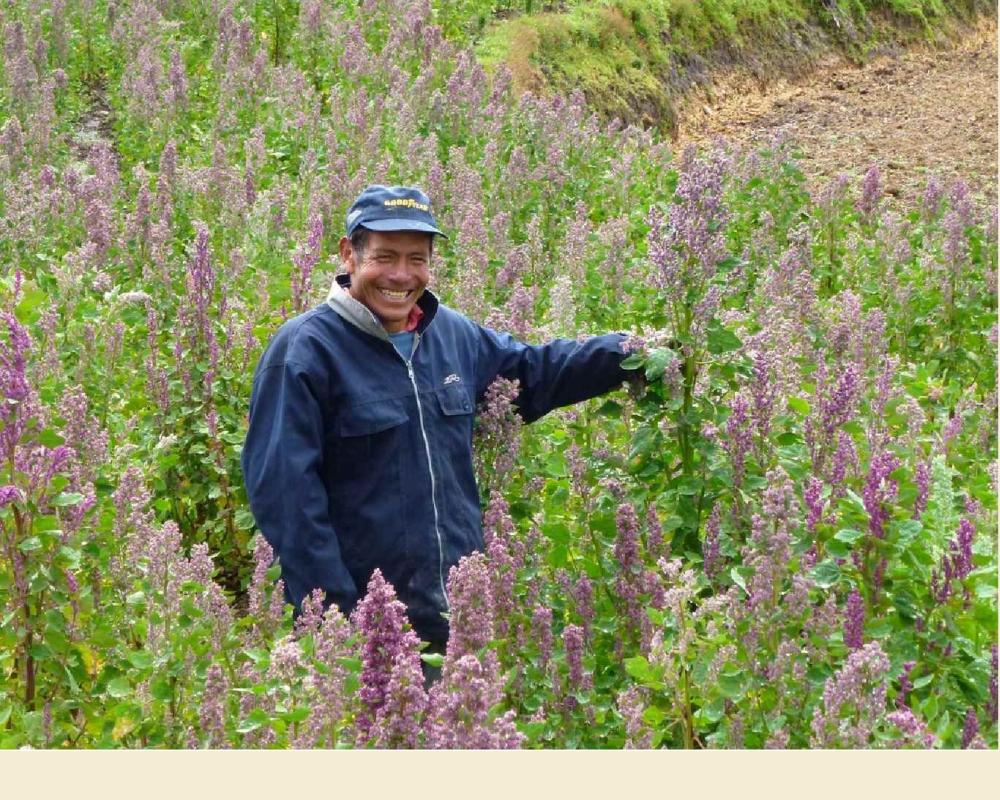QUINOA from Peru
18.11.15

Quinoa is called a pseudocereal, because like cereals it is an annual plant that produces a large ear rich in seeds, but it belongs to the Chenopodiaceae family, which includes spinach, chard, beets, etc.. Originally from the Andes, quinoa is a very adaptable crop resistant to drought, cold and salinity, spread from 3500 meters to coastal regions, especially in Peru, Ecuador, Bolivia, Chile and Argentina. Among the nutritional peculiarities of this plant are the absence of gluten and the abundance of fiber and proteins, especially essential amino acids, as well as unsaturated fatty acids and many micronutrients.
Our local partner has been producing food originating from Andean biodiversity with certified organic methods for 8 years, such as pseudocereals (quinoa and amaranth), native tubers and legumes (yacon, maca, beans and Andean lupins), and native fruits (Physalis, Aguaje), as well as dehydrated mangoes and bananas. It currently has more than 200 hectares of Peruvian Physalis, 25 hectares of yacon and almost 100 hectares of quinoa active. All of these supply chains comply with the principles of Fair Trade and many are certified Fair Trade USA.
The products come from a network of more than 400 small producers, Andean families of Quechua culture and language with plots of 1-2 hectares on average, who live in different Andean and High Andean provinces of the Cajamarca region, in northern Peru. The partner works closely with farmers and promotes association processes between producers, provides free training-consultancy-technical assistance and supports the farmers' certification process.
The local company is also a member of the Union for Ethical Biotrade, which brings together companies that work with native biodiversity products and develop specific ethical and operational protocols to protect the territory and local populations.
Quinoa is cultivated in the Andean region between 2000 and 3500 meters above sea level and local varieties adapted to the climate and territory of Peru are used, and whose grains are smaller in size compared to Bolivian varieties. The main varieties are: white quinoa varieties Salcedo, Blanca Junìn and Huallhuaus, Pasankaia red quinoa and black quinoa, which are often sown together to increase the diversity of the field and reduce the impact of any parasites or extreme weather events.
The quinoa harvest takes place manually, between February and June, it is then dried in the sun and in the most isolated communities, which maintain a high self-consumption of quinoa, this is sieved in the wind according to the traditional method. The processing takes place in Lima, where the seeds are cleaned, selected, washed by saponins (indigestible substance present only by external extraction) and packaged.
An annual plant similar to cereals that produces an enormous ear very rich in grains, it is an example of Andean agricultural biodiversity because it is very adaptable to extreme conditions and rich in ecotypes and local varieties with specific organoleptic and cultural properties. White, red and black varieties are known and are often cultivated together, and Peruvian varieties are smaller (1-2 mm) than Bolivian varieties (2-3 mm). The grains are covered with an indigestible substance, saponin, which is eliminated by simple soaking and washing in water.
The worldwide fashion for this food has produced speculative processes in Bolivia and Peru, detrimental to the food security of rural communities of Andean peasants. Therefore, the sustainability of this supply chain lies not only in reducing the environmental impact, respecting traditional agricultural practices (organic fertilization, planting of multiple varieties, associations with other species, rotations, biological control of parasites, etc.), but also in continuous and supportive relationships with small producers and in recognizing them a higher price than the market price.
The supply chain of this product was born in the Cajamaca region in northern Peru, in family plots of a few hectares, where it is cultivated by rural communities and farmers' associations between 2000 and 3500 m, with traditional sustainable agricultural methods. The harvest is between February and June; cleaning and selection of grains, washing of saponins and packaging take place in Lima in a plant that does not process foods containing gluten and allergens (sesame, soy, peanuts, nuts, etc.). The product complies with the Organic Management System (EC.No.834/2007) and the principles of Fair Trade. (: a greater economic impact based on the supply chain, respect for wage rights, support for association processes, free technical assistance-advice, etc.) (The local partner is also a member of the Union for Ethical Biotrade: which brings together companies that work with native biodiversity products and develop specific ethical and operational protocols to protect the territory and local populations.)
It is rich in proteins and essential amino acids, fibers and micronutrients. It's gluten-free.
It is generally prepared boiled and can be eaten alone seasoned or mixed with other cereals and vegetables, also ideal for soups, meatballs, fillings, timbales, etc.
Our local partner has been producing food originating from Andean biodiversity with certified organic methods for 8 years, such as pseudocereals (quinoa and amaranth), native tubers and legumes (yacon, maca, beans and Andean lupins), and native fruits (Physalis, Aguaje), as well as dehydrated mangoes and bananas. It currently has more than 200 hectares of Peruvian Physalis, 25 hectares of yacon and almost 100 hectares of quinoa active. All of these supply chains comply with the principles of Fair Trade and many are certified Fair Trade USA.
The products come from a network of more than 400 small producers, Andean families of Quechua culture and language with plots of 1-2 hectares on average, who live in different Andean and High Andean provinces of the Cajamarca region, in northern Peru. The partner works closely with farmers and promotes association processes between producers, provides free training-consultancy-technical assistance and supports the farmers' certification process.
The local company is also a member of the Union for Ethical Biotrade, which brings together companies that work with native biodiversity products and develop specific ethical and operational protocols to protect the territory and local populations.
Quinoa is cultivated in the Andean region between 2000 and 3500 meters above sea level and local varieties adapted to the climate and territory of Peru are used, and whose grains are smaller in size compared to Bolivian varieties. The main varieties are: white quinoa varieties Salcedo, Blanca Junìn and Huallhuaus, Pasankaia red quinoa and black quinoa, which are often sown together to increase the diversity of the field and reduce the impact of any parasites or extreme weather events.
The quinoa harvest takes place manually, between February and June, it is then dried in the sun and in the most isolated communities, which maintain a high self-consumption of quinoa, this is sieved in the wind according to the traditional method. The processing takes place in Lima, where the seeds are cleaned, selected, washed by saponins (indigestible substance present only by external extraction) and packaged.
An annual plant similar to cereals that produces an enormous ear very rich in grains, it is an example of Andean agricultural biodiversity because it is very adaptable to extreme conditions and rich in ecotypes and local varieties with specific organoleptic and cultural properties. White, red and black varieties are known and are often cultivated together, and Peruvian varieties are smaller (1-2 mm) than Bolivian varieties (2-3 mm). The grains are covered with an indigestible substance, saponin, which is eliminated by simple soaking and washing in water.
The worldwide fashion for this food has produced speculative processes in Bolivia and Peru, detrimental to the food security of rural communities of Andean peasants. Therefore, the sustainability of this supply chain lies not only in reducing the environmental impact, respecting traditional agricultural practices (organic fertilization, planting of multiple varieties, associations with other species, rotations, biological control of parasites, etc.), but also in continuous and supportive relationships with small producers and in recognizing them a higher price than the market price.
The supply chain of this product was born in the Cajamaca region in northern Peru, in family plots of a few hectares, where it is cultivated by rural communities and farmers' associations between 2000 and 3500 m, with traditional sustainable agricultural methods. The harvest is between February and June; cleaning and selection of grains, washing of saponins and packaging take place in Lima in a plant that does not process foods containing gluten and allergens (sesame, soy, peanuts, nuts, etc.). The product complies with the Organic Management System (EC.No.834/2007) and the principles of Fair Trade. (: a greater economic impact based on the supply chain, respect for wage rights, support for association processes, free technical assistance-advice, etc.) (The local partner is also a member of the Union for Ethical Biotrade: which brings together companies that work with native biodiversity products and develop specific ethical and operational protocols to protect the territory and local populations.)
It is rich in proteins and essential amino acids, fibers and micronutrients. It's gluten-free.
It is generally prepared boiled and can be eaten alone seasoned or mixed with other cereals and vegetables, also ideal for soups, meatballs, fillings, timbales, etc.
PREVIOUS ARTICLE
04. 11. 15
04.11.15
We support the Farmhouse A Lanterna
The A Lanterna Farmhouse located in Monasterace Marina, adjacent to the archaeological site that “preserves” the remains of ancient Kaulonia, has suffered yet another mafia attack with the s...
Read



